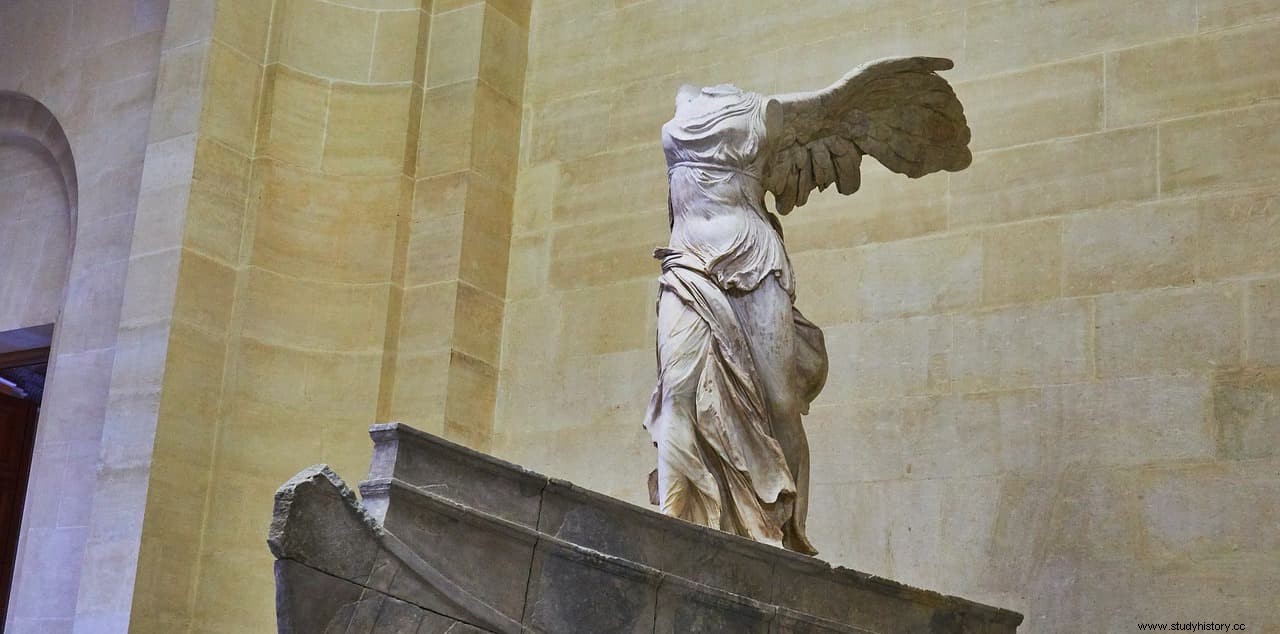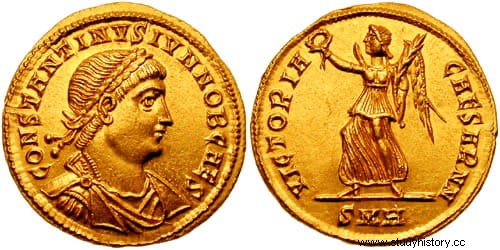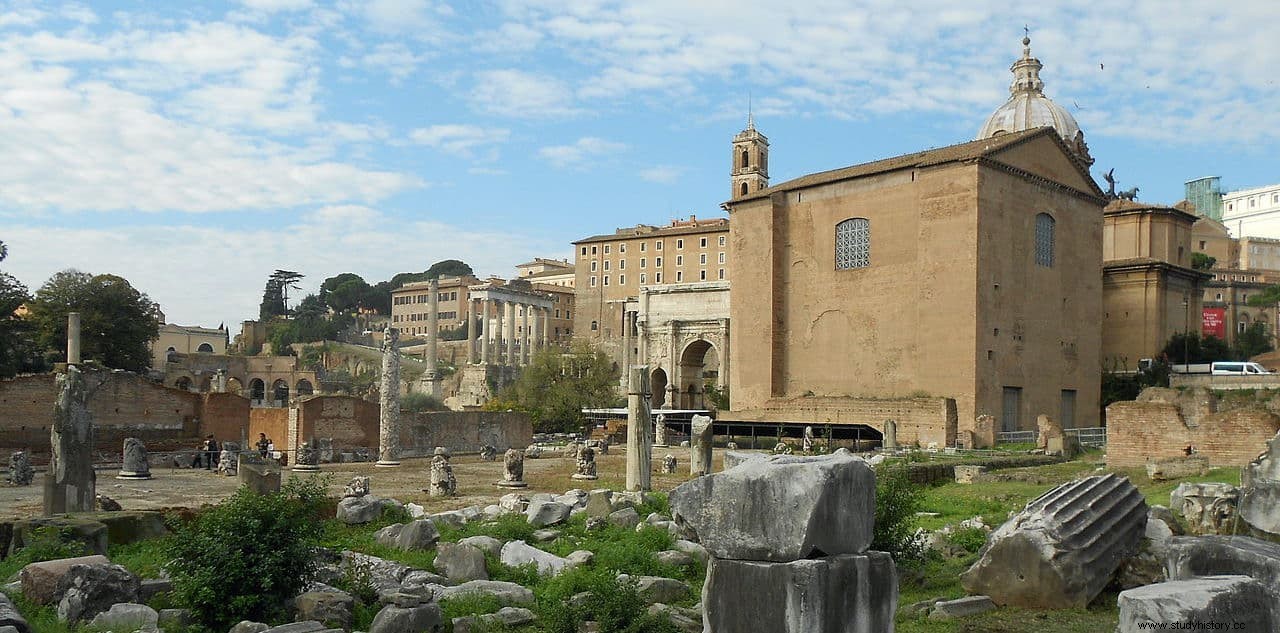As if late-imperial Rome hadn't had enough fronts to deal with, in the 4th century AD. another one opened up to him as unexpected as it lasted -almost a hundred years-, and with somewhat surreal overtones because it was not developed against external or internal enemies but consisted of a harsh controversy between Christian and pagan senators to place or remove a statue of the Curia. It is popularly known as the War of the Statues , although in reality there was only one protagonist:that of the goddess Victoria.
Victoria, as anyone can deduce, was the divinity of triumphs, fundamentally -at least in the Roman case- of those achieved on the battlefield. That is why she used to be associated with Bellona, daughter of Jupiter and Juno, sister or wife of Mars and, consequently, goddess of war (in fact, she was probably the original Roman deity in that field, Mars being a mere later adaptation of the Greek Ares). ). If Bellona had her sanctuary on the Palatine Hill from the 3rd century B.C. until its disappearance due to a fire in the year 48 AD, Victoria had two, one also on the same hill and another in the Capitol.

Actually, this goddess was also an import from Hellenic mythology:the Roman version of Nike, duly combined in triple syncretism with the Sabine Vacuna (who also contributed characteristics to Ceres, goddess of agriculture) and with Vica Pota (possibly a primitive of the victory derived from the Etruscan Lasa Vecu). However, Nike's usual field of action was sports, while Victoria symbolized, above all, the triumph over death and, therefore, was rather linked to war, hence she was often shown holding a shield .
Daughter of the titan Pallas and the oceanic nymph Styx, Victoria would have Zelo, Cratos and Bía as siblings (according to another version, Potestas, Vis and Invidia, and even Eos and Selene). She her appearance was of a winged female figure, carrying in her hands a palm and the laurel wreath that she would deliver to the victor (or the scutum , as we said); that image would become very frequent in the iconography of ancient Rome, appearing on coins, spandrels (the corners that remain between an arch and the columns that flank it), metopes, etc. The fact that she looks so much like a typical Christian angel has allowed many artistic representations to survive that simply changed identity when the state adopted that religion.

But here we are going to talk about a statue of Victoria in particular. The one that was erected on an altar located inside the Curia Julia, the building where the Senate used to meet. Octavio Augusto ordered it to be placed there in the year 29 BC, to celebrate his triumph in the battle of Accio against the fleet of Marco Antonio and Cleopatra. The importance of that confrontation was such - he was left alone with power - that he had previously ordered the erection of a monument in his own castrum with the spurs of captured enemy ships, probably following the model of the rostral columns that Gaius Duilio Nepos built in Rome in 260 BC, after defeating the Carthaginians at Milas.
The statue in question was made of gilded bronze and not of Roman but Greek manufacture:it was part of the booty captured in 272 BC. by the legions to the tarentines (Tarento was a Hellenic city of Magna Graecia, that is, the south of the Italian peninsula), after defeating Pirro, king of Epirus; therefore, it was a representation of Nike. The installation of the altar was also going to serve to accompany the inauguration of the aforementioned Julia Curia, which was so called because Julius Caesar began to build it in 44 BC. but it had been finished by Octavio, already named Augustus in 27 B.C. The building stood in the forum, not far from the Curia Hostilia, and also had a statue of Victoria crowning the outer pediment.
In this way, the Altar of Victory became an important ceremonial center, where people prayed periodically for the welfare of the empire while burning incense and where they took an oath when assuming office. That order was maintained for three centuries, but in the IV the panorama changed considerably:Christianity had not only managed to survive the persecutions but also became a generalized cult that the emperors could no longer ignore or repress. Therefore, it was necessary to confer legality on it, and that was what Constantine did in 313 AD, through the Edict of Milan.
Christians were able to practice their rites out of hiding and regain property that had been confiscated from them, allowing many to regain their former status and catch up with practitioners of the traditional Roman religion. Obviously, sparks soon flew, as the latter were unwilling to lose ground, and Victoria became the subject of disputes between both sides. Or, to be exact, the statue that presided over the altar of Augustus, which the Christians wanted to remove because it was a too visible symbol -there were few places as public as that one- of paganism.
The tug-of-war began in 357 AD, when Constantius II, Constantine's second son and converted to the Christian faith, ordered its removal. The vacuum did not last long, since his cousin Juliano, who received the nickname Apostate pretending to return to traditional religion, he reestablished the goddess on his pedestal. But the pagan attempt of this emperor would be useless and all his successors reaffirmed Christianity, hence, although Valentinian I maintained it, his son Gratian lowered the statue again in 382 AD.
Valentinian, a soldier with little training, was a Christian but tolerant, so he allowed freedom of worship. Two years earlier, Theodosius had promulgated the Edict of Thessalonica, which under the title Cunctos Populos converted Christianity from the Council of Nicaea into the official religion of the empire. The measure did not imply the prohibition of other religions, which could continue to be practised, but rather it was directed against heresies and, specifically, against Arian theses.

Instead, Gratian was a fervent believer who heeded the demands of those senators who were devoted to Christ, as well as the prestigious bishop of Milan, Saint Ambrose, under whose influence an anti-pagan policy was applied. He was also influenced by Saint Dámaso, a pope famous for ordering his secretary Saint Jerome to translate the Bible into Latin (the Vulgate ) and that today is the patron saint of archaeologists, curiously. Gratian outlawed pagan religious rituals, refused to take over as Pontifex Maximus , he pressured the clergy of the traditional religion, prohibited donations to the Vestals and confiscated the income of non-Christian senators, forcing the citizenry to adopt the Nicene faith to prevail over Arianism and other currents.
However, this Christianizing trend did not prevent Valentinian II, half-brother of the emperor, whom he succeeded to the throne (with the help of Theodosius, who reigned in the East and was in charge of eliminating the usurper Magno Clemente Máximo), from having to rethink the problem two years later. It was at the initiative of Senator Quinto Aurelio Simmaco, who from his position as prefect of Rome wanted to maintain the traditions and considered that it was convenient to have the favor of Victoria to contain the barbarians, just as in the past with Hannibal. Since Simmaco was also a writer, he added deeper motives:the tolerant coexistence of two different creeds to seek the truth of the universe.
He asked Valentinian in a letter he sent him, entitled Relatio tertia in reptenda ara Victoriae . The proposal was denied because the court was in Milan, episcopal see of the aforementioned Saint Ambrose, who in turn sent the emperor two epistles warning him of the incompatibility of the true God with the false ones. So the altar was not restored, despite popular unrest caused by the decision. In fact, an even darker future was presented to him in 391 AD, when Theodosius issued a series of decrees that further curtailed pagan practices:prohibition of sacrifices (even in the private sphere), Christianization of temples, sanctions for baptized who reneged…

Although initially only fines were foreseen, the resistance to accept the laws led to conflicts (perhaps the most serious, that of Alexandria, where the temple of Serapis ended up burning) and in 392 AD. capital punishment was ordered as a deterrent. However, Theodosius did not apply this repressive policy with intensity because he knew that the bulk of the army remained faithful to the old cult and did not want to risk a mutiny, so he was content to carry out a few measures, among them the refusal to restore the Altar of Victory. Now, it ended up returning because Theodosius ruled from Milan, but in Rome Flavius Eugenius, an obscure pagan military man (or tolerant Christian, according to another version) had taken power, who ignored his decrees.
Inevitably, they ended up at odds two years later and the usurper, defeated, was sentenced; Victoria had not appreciated his gesture and paid for it by being removed from her pedestal one more time, the last time. Theodosius died a little later, in 395 AD, dividing the empire between his two sons:Honorius in the West and Arcadius in the East. Before the first, who had his court in Milan, Simmaco appeared, unattainable to discouragement, leading a new delegation from the Senate, where the pagans were still the majority, requesting the replacement of the altar. He was in the year 402 AD. and his time had passed:Honorius not only rejected him but ordered the monument to be destroyed.
It's actually unclear if his ending was exactly like that. There are historians who believe that this bloodless war only affected the altar of Augustus and not the statue of the goddess, which would have always remained in its place (it is a saying because it is known that several fires destroyed the monument and it was necessary to make at least one copy). If this is true, what became of her is unknown, although it is most likely that she ended up condemned by the law against pagan images that, according to the Codex Theodosianus (a legislative compilation promoted by Theodosius II in 429 AD) promulgated by that same emperor in 408 AD. And it is that the process of Christianization was already unstoppable and irreversible; including senators.
